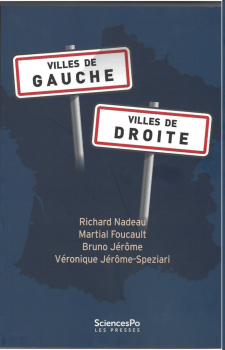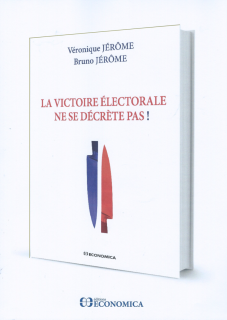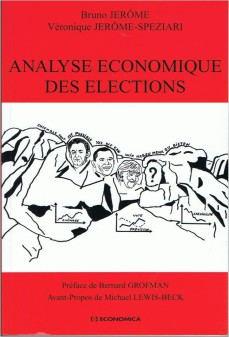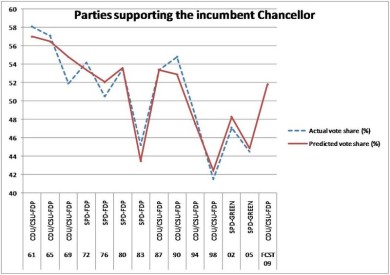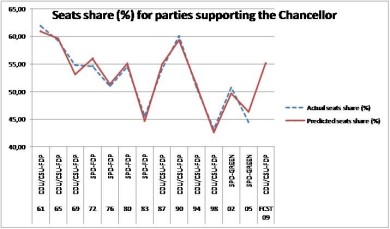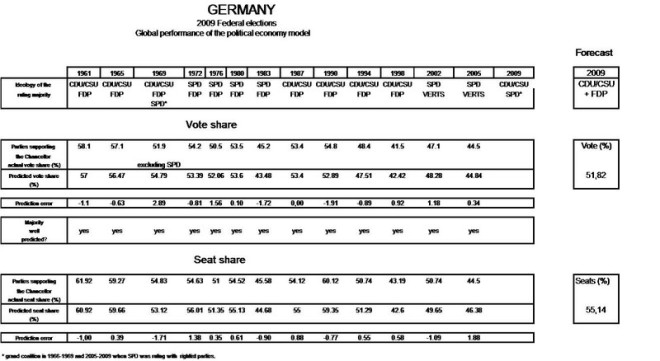A political-economy forecast for the 2009 German elections
(September 27): The end of the Grand Coalition?
Bruno Jérôme (University of Paris II, IRGEI-LARGEPA Paris II- France),
Véronique Jérôme-Speziari (University of Paris Sud XI- LARGEPA Paris II- France)
Michael S. Lewis-Beck (University of Iowa, Department of Political Science- USA)
In Germany, as political economy models tend to show, national election results are highly linked to the economic situation[i], maybe more than in the other western democracies. Correlatively, the economic performance is partly attributed to the incumbent coalitions. However, since 1998 even if economy still strongly matters, the electoral power of hinge parties such as the FDP or the Greens, makes or breaks majorities.
Forecasts issued from our politico-economic vote function provided satisfactory results in 1998, predicting Helmut Kohl’s defeat[ii]. On the other hand, in 2002 the same model gave disappointing results[iii]. The main problem was the model did not include the credibility of the Greens or the Free Democrats. This improvement helped us to forecast well the likelihood of a grand coalition SPD-CDU in 2005[iv].
In accordance with our 2005 model, the votes for parties supporting the outgoing Chancellor are explained by the economic situation (precisely the rate of unemployment, two quarters before an election) and the credibility (popularity) of the allied parties whose votes are required to reach a majority (the Greens for the SPD and the FDP for the CDU/CSU).
The basic specification of the vote function is:
The German elections are essentially explainable by the Economy and the credibility (popularity) of the hinge parties driving to a stable coalition, ceteris paribus.
VOTE (%) = f (ECONOMY ; HINGE PARTIES CREDIBILITY; DUMMY VARIABLE)
After estimating the parameters of the model (Ordinary Least Squares)[1] for the period 1961-2005, we plugged pre-electoral economical and political data into the model in order to forecast the score for the (homogeneous) coalition supporting the Chancellor. Then, using a swing ratio, we turn the predicted votes into potential seats at the Bundestag.
Econometric estimation of the vote function (OLS)
V = 45.33 - 1.17 U t-2 + 1.60 HINGEPARTY t-1 + 4.55 DUM87 + et (19.9) (-10.25) (5.04) (2.72)
Adj. R² = 0.90 ; SER = 1.59 ; DW = 2.14 ; N = 13 ; t- stat between brackets
V : vote share (%) for the coalition supporting the Chancellor (CDU/CSU+FDP or SPD-VERTS)
U : Unemployment rate in the two quarters preceding the election date
HINGEPARTY : average popularity for the hinge parties (SPD or the FDP) two quarters preceding the election date according to the nature of the ruling coalition.
DUM87 : dummy variable coded 1 (0 otherwise ) in 1987 when H. Kohl is first time presenting as « true » outgoing candidate (this was not the case in 1983).
Swing Ratio:
SEATS (%) = f (VOTES (%) ; DUMMY VARIABLE)
Among the basic determinants of the vote function, the average rate of unemployment two quarters before the election date is 8.3 (percentage of the labor force). That is the lowest rate of unemployment since 1994 that an outgoing Chancellor has had to face, despite the fact that economic crisis has boosted the rate of unemployment (+ 1 point since September 2008).
ECONOMETRIC ESTIMATION OF THE SWING RATIO
S = -12.21 + 1.25 V + 2.58 REUNIF
(-2.82) (15.46) (3.14)
Adj. R² = 0.96 ; SER = 1.18 ; DW = 2.66 ; N = 13 ; t- stat between brackets
S : Seats share (%) for the coalition supporting the Chancellor (CDU/CSU+FDP or SPD-the Greens)
V : Vote share (%) for the coalition supporting the Chancellor (CDU/CSU+FDP or SPD-the Greens)
REUNIF : Dummy variable coded 1 (0 otherwise) starting from 1990 in order to distinguish between pre-reunification and post-reunification periods.
Moreover, the average popularity for the FDP two quarters before the election date is 14.6, that is to say its best pre-electoral popularity for the period 1961-2009.
According to this propitious politico-economic situation, a CDU/CSU-FDP coalition could expect 51.82 percent of the votes cast, translating into 55.14 percent of the total seats in the Bundestag. Tellingly, this provides 52 extra seats compared to 2005 and a potential 32 seats majority.
If the German voters behave on average the same way they did in the past, this should be the end of the Grand Coalition.
[1] Parameters and equations are also available on electionscope website (www.electionscope.fr)
[i]Jérôme Bruno, V. Jérôme-Speziari, et M. Lewis-Beck [2001], « Evaluation économique et vote en France et en Allemagne », in l’Opinion européenne 2001, Presses de sciences Po., avril, p. 101-122.
[ii]Jérôme Bruno, Véronique Jérôme-Speziari et Michael Lewis-Beck [1998] « prévisions politico - économiques et élections législatives allemandes de septembre 1998 », Rubrique cheminement du futur, Le Figaro économie, 10 juillet.
[iii]Jérôme, Bruno, V. Jérôme-Speziari, et M. Lewis-Beck, [2002], Pourquoi Stoiber peut (encore) gagner, Le Figaro, mercredi 18 septembre, p.17.
[iv]Jérôme-Speziari Véronique (2005) Prévision des élections allemandes de 2005 : vers une grande coalition. Interview from Emmanuel Duteil on BFM radio, september 2005.
Eine Prognose für die Bundestagswahl: Das Ende der großen Koalition?
Danksagung
Wir bedanken uns bei Dr. Andreas Graefe, Wissenschaftler am Karlsruhe Institut für Technologie, für die Übersetzung des Textes ins Deutsche. Herr Graefe ist mitverantwortlich für das PollyVote (www.pollyvote.com) Projekt zur Vorhersage des Ausgangs der U.S. Präsidentschaftswahlen.
Politisch-ökonomische Vorhersagemodelle zeigen eine starke Abhängigkeit des Wahlausgangs von der ökonomischen Situation eines Landes.[1] In Deutschland scheint dieser Zusammenhang dabei noch starker ausgeprägt als in den anderen westlichen Demokratien. So sehen die Wähler die Verantwortung für den Zustand der Volkswirtschaft in der Regel bei der Koalition. Die wirtschaftliche Situation spielt also eine gewichtige Rolle für den Ausgang der Bundestagswahl, auch wenn meist die kleinen Parteien, wie FDP oder Grüne, letztlich über das Zustandekommen von Mehrheiten entscheiden.
Unser politisch-ökonomisches Vorhersagemodell lieferte bereits 1998 zufriedenstellende Ergebnisse und prognostizierte die Niederlage von Helmut Kohl[2], scheiterte jedoch mit seiner Prognose im Jahr 2002.[3] Das Hauptproblem dabei war, dass die Stärke der Grünen sowie der FDP nicht im Modell abgebildet waren, was für die letzte Wahl im Jahr 2005 zu Änderungen am Vorhersagemodell führte. Mit Erfolg, im Jahr 2005 lieferte das Modell eine akzeptable Vorhersage der Wahrscheinlichkeit für das Zustandekommen einer großen Koalition.
Unser Modell prognostiziert den Stimmanteil der Parteien, welche den Amtsinhaber, d.h. in diesem Jahr Angela Merkel, unterstützen. Dabei wird auf zwei Variablen zurückgegriffen: (1) die ökonomische Situation des Landes (gemessen anhand der Arbeitslosenquote zwei Quartale vor dem Wahltag) und (2) die gemeinsame Popularität der Parteien, die für eine Mehrheit in Frage kommen (d.h. rot-grün für SPD und Grüne und schwarz-gelb für CDU/CSU und FDP).
Um die Modellparameter für die Vorhersage für 2009 abzuschätzen, verwendet unser Modell Daten aus dem Zeitraum von 1961 bis 2005.[4] Aus dem prognostiziertem Stimmanteil für eine schwarz-gelbe Koalition werden letztlich die Anzahl der möglichen Sitze im Bundestag berechnet.
Die Haupteinflussgröße für die Prognose, nämlich die durchschnittliche Arbeitslosenquote während der letzten zwei Quartale vor dem Wahltag, beträgt 8,3 Prozent. Obwohl die Arbeitslosenquote damit aufgrund der Krise um einen Prozentpunkt seit September 2008 angestiegen ist, ist dies ist der niedrigste Wert für einen Kanzler seit 1994. Darüber hinaus lag die FDP in Umfragen in den letzten zwei Quartalen durchschnittlich bei etwa 14,6 Prozent – das beste Umfragenergebnis für den gesamten Zeitraum von 1961 bis 2009.
Auf Basis dieser politisch-ökonomischen Situation prognostiziert unser Modell einen Stimmanteil von 51,82 Prozent für eine Koalition aus CDU/CSU und FDP, oder 55,14 Prozent der Sitze im Bundestag. Damit würde schwarz-gelb 52 Sitze hinzugewinnen – eine Mehrheit von 32 Sitzen im Bundestag.
Falls sich die deutschen Wähler in etwa so verhalten, wie sie das früher getan haben, sollte dies das Ende der großen Koalition bedeuten.
[1]Jérôme Bruno, V. Jérôme-Speziari, et M. Lewis-Beck [2001], « Evaluation économique et vote en France et en Allemagne », in l’Opinion européenne 2001, Presses de sciences Po., avril, p. 101-122.
[2]Jérôme Bruno, Véronique Jérôme-Speziari et Michael Lewis-Beck [1998] « prévisions politico - économiques et élections législatives allemandes de septembre 1998 », Rubrique cheminement du futur, Le Figaro économie, 10 juillet.
[3]Jérôme, Bruno, V. Jérôme-Speziari, et M. Lewis-Beck, [2002], Pourquoi Stoiber peut (encore) gagner, Le Figaro, mercredi 18 septembre, p.17.
[4] Modellparameter und –gleichungen sind online verfügbar auf www.pollyvote.com und www.electionscope.fr.

